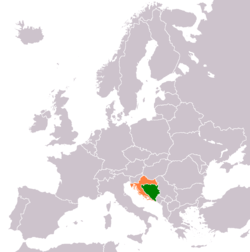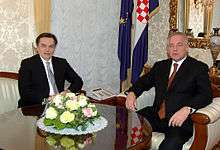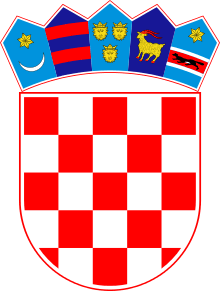Bosnia and Herzegovina–Croatia relations
Bosnia and Herzegovina–Croatia relations are foreign relations between Bosnia and Herzegovina (BiH) and Croatia. Both countries established diplomatic relations on July 7, 1992. Bosnia and Herzegovina has an embassy in Zagreb, while Croatia has an embassy in Sarajevo and 6 consulates in Sarajevo, Banja Luka, Mostar, Tuzla, Livno and Vitez .[1] The two countries share a 932-kilometer (579 mi) border.
 | |
Bosnia and Herzegovina |
Croatia |
|---|---|
The majority of population in Bosnia and Herzegovina and in Croatia speak Serbo-Croatian; one of its standard varieties, Croatian, is official in both countries. Bosnian and Serbian, the other standard varieties official in Bosnia and Herzegovina, are recognized as minority languages of Croatia.
Both countries are full members of the Council of Europe.
Diplomatic relations

Bosnia and Herzegovina's and Croatia's diplomatic relations started with Croatia recognizing Bosnia and Herzegovina on 24 January 1992,[2] which Bosnia and Herzegovina reciprocated on 7 April the same year,[3] and both countries finally signed an agreement of mutual friendship and co-operation on 21 July the same year, during the series of Yugoslav Wars.[4][5] Together, Bosnia and Herzegovina and Croatia have signed 111 various treaties deliminating issues ranging from establishment of diplomatic missions to resolving border disputes.[5]
The Croatian embassy in Bosnia and Herzegovina is located in Sarajevo and its 6 consulates are located in Sarajevo (consulate-general), Banja Luka, Mostar, Livno, Vitez and Tuzla. The current Croatian ambassador in BiH is Ivan Sabolić.[6] Current BiH ambassador in Croatia is Azra Kalajdžisalihović.[7]
Bosnia and Herzegovina has its embassy in Zagreb. Beside the embassy, there is one consulate-general of Bosnia and Herzegovina in Croatia, also located in Zagreb.[8] As of 2014 ambassador of Bosnia and Herzegovina to Croatia is Azra Kalajdžisalihović.[9]
Extradition
As of May 2009, Bosnia and Herzegovina and Croatia have not signed a treaty of mutual extradition of the countries' citizens, owing to many convicted people fleeing to the other country and attaining dual citizenship to be virtually immune to extradition. These people have included Ognjen Šimić, a surgeon from Rijeka convicted to nine years in prison for accepting bribes; Ante Jelavić, a former president of the Presidency of Bosnia and Herzegovina convicted in Croatia to 9.5 years for alleged abuse of position at the Bank of Herzegovina in Mostar; and others. The two countries are working on an agreement. According to Bosnia and Herzegovina government, fourteen people sentenced in Bosnia and Herzegovina live self-exiled as Croatian citizens. The two countries are, as of 2009, working on an agreement that would allow imprisoning such escapees for their sentences within their current country of residence without their consent (the status quo version requires consent of the escapee, which is usually not given).[10][11]
Yugoslav Wars
Both Bosnia and Herzegovina and Croatia were engaged in the early-1990s Yugoslav wars, armed conflicts which followed the break-up of SFR Yugoslavia into five sovereign countries: Bosnia and Herzegovina, Croatia, Republic of Macedonia, Slovenia, and FR Yugoslavia (later broken up into Serbia, Montenegro and Kosovo). Croats, Bosniaks and Serbs (including Bosnian Croats and Bosnian Serbs) fought each other exchanging alliances in a series of conflicts. The majority of the wars were fought on Bosnia–Herzegovina territory, where Croats established the Croatian Republic of Herzeg-Bosnia. However, after the wars Bosnia and Herzegovina and Croatia retained the same border they had during SFR Yugoslavia, and through the Dayton Accords, Bosnia and Herzegovina was divided into two entities based on three constituent peoples: Republika Srpska (for Serbs) and Federation of Bosnia and Herzegovina (for Bosniaks and Croats). According to the CIA World Factbook, 7,269 Croatian refugees still live in Bosnia and Herzegovina and the country has 131,600 internally displaced persons.[12][13] Recently, Haris Silajdžić, a member of the Presidency of Bosnia and Herzegovina, has criticized the Dayton Accords and their results.[14]
Economic development

As Bosnia and Herzegovina and Croatia each share the largest part of their border with the other (932 kilometers or 579 miles), they have participated in numerous joint ventures aimed at providing a regional economic uplift. One of such projects is the widening of Pan-European Corridor Vc (E73) to freeway standards.[5] Although extending to the Adriatic Sea all the way from Budapest, the capital of Hungary, Corridor Vc (in Bosnia and Herzegovina designated as A1) is purported to bear most importance for Bosnia and Herzegovina as its longest turnpike (at 340 kilometers or 210 miles) and a national project of sorts.[15] It passes through Croatia at two stretches: one in eastern Slavonia near Osijek and Đakovo (A5) and the other at the coast near Ploče and Metković (A10). Croatia and Bosnia and Herzegovina have so far co-operated in building a bridge over Sava River near Svilaj, Croatia, which connects the northern end of Corridor Vc to the southern end of Croatian A5.[5]
Trade
Exports to Bosnia and Herzegovina amount to 14.4% of Croatia's total, while as of 2007, Bosnia and Herzegovina is the fifth largest trade partner of Croatia. This makes Croatia both the largest importer and exporter of Bosnia and Herzegovina, while Bosnia and Herzegovina is the second largest buyer of Croatian goods. With 343 million convertible marks (US$237 million) of invested foreign capital, Croatia is the largest investor in Bosnia and Herzegovina, topping nearby Slovenia (BAM 302 million; US$208 million) and neighboring Serbia and Montenegro (BAM 122 million; US$84 million). In 2007, the trade between the two countries amounted to 2,517 million US dollars (BAM 3.64 billion; HRK 13.63 billion), a 32% increase from the past year.[16][17]
Border issues
The two countries have several small disputed sections of the boundary, the most prominent of which is the one related to maritime access. The ratification of the 1999 border agreement has not happened as of 2017.
Una
Sections of the Una River and villages at the base of Mount Plješevica are in Croatia, while some are in Bosnia, which means that there would have to be nine border crossings on a single route. Lack of action on this problem impedes any serious development in the region. The Zagreb–Bihać–Split railway line is still closed for major traffic due to this issue.[18]
The border on the Una River between Hrvatska Kostajnica on the northern, Croatian side of the river, and Srpska Kostajnica on the southern, Bosnian side, is also being discussed. A river island between the two towns is under Croatian control, but is claimed by Bosnia and Herzegovina. A shared border crossing point has been built and has been functioning since 2003, and is used without hindrance by either party.
Neum
The Herzegovinian municipality of Neum in the south makes the southernmost part of Croatia (Dubrovnik–Neretva County) an exclave. In 1999, a border agreement between former Croatian President Franjo Tuđman and President of Bosnia and Herzegovina Alija Izetbegović moved the Croatia – Bosnia and Herzegovina border near Neum from the very coast (during SFR Yugoslavia era and confirmed by the Badinter Arbitration Committee) further into the sea waters of the Mali Ston Bay, placing two Croatian islands (Mali and Veliki Škoj, incidentally translated into English as Little and Big Island) under Bosnia-Herzegovina sovereignty. Six years later, the Croatian government called for the ratification of this agreement; however, as of 2007, it was not ratified.[19][20] The two countries negotiated Neum Agreement and Ploče Agreement defining special arrangements for Croatian transit traffic through Neum and Bosnia and Herzegovina access to the port of Ploče to compensate for non-contiguity of Croatian territory between Ploče and Dubrovnik and lack of a seaport in Bosnia and Herzegovina.[21][22]
Recently Croatia has opted to build a bridge to the Pelješac peninsula to connect the Croatian mainland with the exclave as part of the A1 motorway Zagreb–Dubrovnik, but Bosnia and Herzegovina protested that it will hinder their access to international waters (although Croatian territory and territorial waters completely surround the ones of Bosnia and Herzegovina) and has suggested that the bridge must be higher than 55 meters (180 ft) to ensure free passage of all types of ships, while Croatia stated that the Neum harbor doesn't currently have a potential to house ships so big.
See also
References
- "Diplomatic Missions and Consular Offices of Croatia - Bosnia and Herzegovina". Embassy of the Republic of Croatia in Bosnia and Herzegovina. Retrieved 2009-04-08.
- "Date of Recognition and Establishment of Diplomatic Relations". Ministry of Foreign Affairs and European Integration of the Republic of Croatia. Archived from the original on 2010-08-13. Retrieved 2009-04-09.
- "Dates of Recognition and Establishment of Diplomatic Relations". Ministry of Foreign Affairs of Bosnia and Herzegovina. Archived from the original on 2011-07-06. Retrieved 2009-04-09.
- "Bilateralni odnosi: Politički odnosi". Embassy of the Republic of Croatia in Bosnia and Herzegovina (in Croatian). Retrieved 2009-04-08.
- "Collection of International Treaties". Embassy of the Republic of Croatia in Bosnia and Herzegovina. Retrieved 2009-04-09.
- "MVEP • Veleposlanstva RH u svijetu • Bosna i Hercegovina, Sarajevo". Mvep.hr. Retrieved 4 January 2018.
- "MVEP • Veleposlanstva stranih država u RH • Bosna i Hercegovina, Zagreb". Mvep.hr. Retrieved 4 January 2018.
- "Diplomatic Missions and Consular Offices - Bosnia and Herzegovina". Embassy of the Republic of Croatia in Bosnia and Herzegovina. Retrieved 2009-04-09.
- Duspara, Mario (2009-05-04). "Uskoro kraj zabrani izručivanja građana RH". Poslovni dnevnik (in Croatian). Retrieved 2009-05-17.
- "Family Reports Politician Ante Jelavić Kidnapped". Javno.hr (in Croatian). 2009-04-09. Archived from the original on 2009-04-10. Retrieved 2009-05-17.
- "Croatia". CIA World Factbook. 2009-04-09. Retrieved 2009-04-13.
- "Bosnia and Herzegovina". CIA World Factbook. 2009-04-09. Retrieved 2009-04-13.
- "Silajdžić: Daytonski sporazum je nepravedan". SEEbiz.eu (in Bosnian). 2009-02-15. Archived from the original on 2009-02-16. Retrieved 2009-04-13.
- "Motorway on Corridor Vc: Pre-feasibility study" (PDF). IPSA Institute. October 2005. Retrieved 2009-04-12.
- "Bilateralni odnosi". Ministry of Foreign Affairs and European Integrations of the Republic of Croatia (in Croatian). Archived from the original on 2008-11-16. Retrieved 2009-05-17.
- "Bilateralni odnosi". Embassy of the Republic of Croatia in Bosnia and Herzegovina (in Croatian). Retrieved 2009-05-17.
- Milan Cimeša (2010-08-06). "Vlakom prema jugu". Novosti (in Serbian). Retrieved 2013-10-20.
- "Predsjednik Vlade RH: Sporazum o granici s BiH nije do kraja pravičan". Croatian Government (in Croatian). Archived from the original on 2011-09-27. Retrieved 2009-04-09.
- Soldić, Zdravka; Selimović; Šenol (2007-03-07). "BiH traži na moru granicu s Italijom". Široki.com (in Croatian). Retrieved 2009-04-12.
- "Neum Agreement, May 1996" (PDF). Technical annex on a proposed loan to the Republic of Croatia for an emergency transport and mine clearing project. World Bank. 15 October 1996. pp. 45–47. Retrieved 15 August 2011.
- "Zbirka međunarodnih ugovora" [Collection of international agreements] (in Croatian). Ministry of Foreign Affairs and European Integration (Croatia). Retrieved 15 August 2011.
External links
- Croatian Embassy in Sarajevo: English (currently down), Croatian
- Bosnia and Herzegovina Ministry of Foreign Affairs on its embassy in Zagreb

